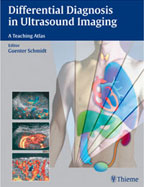The sure way to accurate ultrasound diagnosis:
With more than 2,500 illustrations, this one-of-a-kind book offers an
entirely new system for using ultrasound imaging to achieve the
correct
diagnosis quickly and reliably.
Covering the full spectrum of normal and pathologic findings in the
human
body, the authors -- all experts in the field -- present a color-
coded
system of more than 250 "drop-down" menus, which lay out all possible
diagnoses at a glance and then guide the user swiftly and surely to
an
accurate diagnosis.
The book's clear layout, flow charts, and text boxes make it possible
to
approach a diagnosis via different pathways, such as sonographic
criteria
(echogenic? distal shadowing?) or with the most likely diagnosis
(pancreatitis? splenic infarction?). The detailed information -- plus
all
of the images -- required for the correct diagnosis are always at
your
fingertips.
Organized anatomically, chapters each begin with a handy review of
important sonographic characteristics and normal findings. The
essential
information for each possible abnormal finding follows, along with
concise
discussions of supplemental techniques, such as B-Mode images,
Doppler
imaging, and the use of contrast media.
Elegantly crafted, concise, and accessible, Differential Diagnosis in
Ultrasound is a tried and tested method for making the most of
ultrasound
as a highly efficient diagnostic tool.
::: 카테고리 :::
5 Spleen 184
§ Infective Cysts ____________________
Infective cysts are rare and are encountered in
less than 2% of all patients infected with hydatid
disease. In most cases the infective agent is
Echinococcus cysticus or E. granulosus.
Most cysts are visualized as anechoic lesions
with a double wall (pericyst and endocyst). In
rare cases they may demonstrate daughter
cysts. In exceptional cases these secondary
cysts may be very small and numerous; and,
because of the large number of wall echoes
(Fig. 5.26), the sonographic appearance of such
a hydatid cyst may resemble that of a hyperechoic
lesion. Intracystic membranes, hydatid
sand (scolicial sedimentation), and calcification
have been reported. In general, the ultrasound
appearance of infective splenic cysts is quite
characteristic, although sometimes they are
hard to differentiate from incidental splenic
cysts. When there is doubt, the diagnosis has
to be confirmed by laboratory work-up.
Hypoechoic Mass
______________________________________________________________________
______
____________________________________
Table 5.4 lists the most important hypoechoic
splenic masses.
§ Invasive Lymphoma
______________________________________________________________________
______
_____________________________________
Splenic involvement may generally be diagnosed
sonographically by the presence of splenomegaly
(primarily in low-grade lymphoma)
or the demonstration of hypoechoic focal or
diffuse textural lesions of the splenic parenchyma.
However, splenic involvement cannot
be ruled out for certain even if the spleen is of
normal size and homogeneous texture.
Ultrasound differentiates between five different
patterns of invasion (Fig. 5.27), with the
micronodular and macronodular invasion as
well as the bulky formation corresponding to
focal parenchymal lesions.
Diffuse splenic involvement. As in all parenchymal
organs, the greatest difficulty ultrasound
faces is with diffuse splenic involvement,
and this is the main reason for the poor
sensitivity (albeit for all imaging modalities) in
diagnosing possible invasion of the spleen.
Compared with the adjacent liver, a normal
spleen will appear to be somewhat more homogeneous.
The (subjective or operator-dependent)
assessment of the splenic texture
should be based on the liver as an in-vivo reference
(▣ 5.5a–c).
Focal parenchymal lesions. The value of ultrasonography
in the detection of focal


